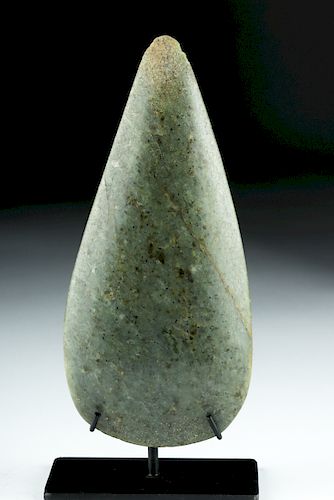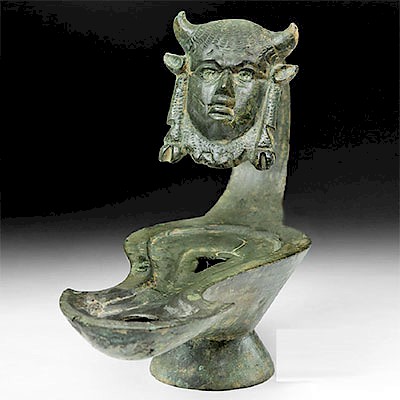Large Taino Greenstone Petaloid Celt
Lot 153b
About Seller
Artemis Gallery
686 S Taylor Ave, Ste 106
Louisville, CO 80027
United States
Selling antiquities, ancient and ethnographic art online since 1993, Artemis Gallery specializes in Classical Antiquities (Egyptian, Greek, Roman, Near Eastern), Asian, Pre-Columbian, African / Tribal / Oceanographic art. Our extensive inventory includes pottery, stone, metal, wood, glass and textil...Read more
Estimate:
$1,500 - $2,000
Absentee vs Live bid
Two ways to bid:
- Leave a max absentee bid and the platform will bid on your behalf up to your maximum bid during the live auction.
- Bid live during the auction and your bids will be submitted real-time to the auctioneer.
Bid Increments
| Price | Bid Increment |
|---|---|
| $0 | $25 |
| $300 | $50 |
| $1,000 | $100 |
| $2,000 | $250 |
| $5,000 | $500 |
| $10,000 | $1,000 |
| $20,000 | $2,500 |
| $50,000 | $5,000 |
| $100,000 | $10,000 |
| $200,000 | $20,000 |
About Auction
By Artemis Gallery
Sep 27, 2018
Set Reminder
2018-09-27 10:00:00
2018-09-27 10:00:00
America/New_York
Bidsquare
Bidsquare : Antiquities | Asian | Ethnographic
https://www.bidsquare.com/auctions/artemis-gallery/antiquities-asian-ethnographic-3469
Featuring classical antiquities, ancient and ethnographic art from cultures encompassing the globe. Artemis Gallery info@artemisgallery.com
Featuring classical antiquities, ancient and ethnographic art from cultures encompassing the globe. Artemis Gallery info@artemisgallery.com
- Lot Description
Pre-Columbian, Dominican Republic, Taino or Ciboney peoples, ca. 1000 to 1500 CE. A beautiful ceremonial hand axe known as a celt, hand-carved from a mottled pistachio-hued stone with light beige and dark inclusions. The petaloid axe has a slender handle end with a conical tip, a wide body with convex faces and acutely-angled sides, and a wide, curved blade edge. This blade would have been hafted onto a wooden handle of a ceremonial hatchet called a "manaya," though there are only limited examples where the handle and blade are carved from a singular contiguous piece of stone. The Yoruba African people that the Spanish brought as slaves to the Caribbean found these stones in fields and linked them to the Yoruba deity Shango (sometimes Chango) because of their thunderbolt shape. Custom museum-quality display stand included. Size: 3.375" W x 7.125" H (8.6 cm x 18.1 cm); 8.2" H (20.8 cm) on included custom stand.
For a stylistically-similar example of a pale-brown color, please see The Metropolitan Museum of Art, accession number 1994.35.421: https://www.metmuseum.org/art/collection/search/317170
Provenance: private Los Angeles County, California, USA collection
All items legal to buy/sell under U.S. Statute covering cultural patrimony Code 2600, CHAPTER 14, and are guaranteed to be as described or your money back.
A Certificate of Authenticity will accompany all winning bids.
We ship worldwide and handle all shipping in-house for your convenience.
#138657Surface wear and minor abrasions commensurate with age, small losses to butt end, minor nicks to blade edge, body, and butt end, with light roughness along edge and butt end. Light earthen deposits throughout. Old inventory label on verso.Condition
- Shipping Info
-
All shipping is handled in-house for your convenience. Your invoice from Artemis Gallery will include shipping calculation instructions. If in doubt, please inquire BEFORE bidding for estimated shipping costs for individual items.
-
- Buyer's Premium



 EUR
EUR CAD
CAD AUD
AUD GBP
GBP MXN
MXN HKD
HKD CNY
CNY MYR
MYR SEK
SEK SGD
SGD CHF
CHF THB
THB














